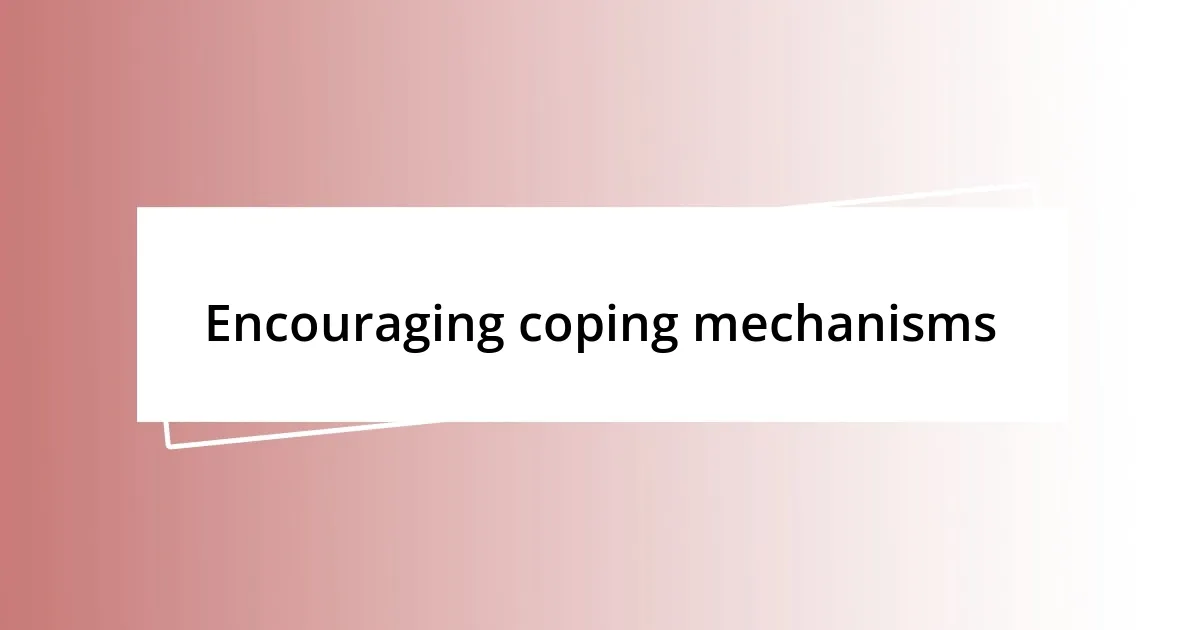Key takeaways:
- Recognizing signs of anxiety in children includes changes in behavior, physical complaints, and emotional indicators like excessive worry.
- Identifying triggers such as social situations, school pressures, and changes in routine helps facilitate open communication between parents and children.
- Effective communication strategies like active listening and validating emotions strengthen the parent-child bond and provide a safe space for expressing feelings.
- Creating a nurturing home environment with calming spaces and daily rituals supports anxiety management and encourages the development of coping mechanisms.

Understanding child’s anxiety symptoms
When I first noticed my child’s anxiety, it wasn’t always obvious. Sometimes, it was just a change in their behavior—suddenly shy, or reluctant to try new things. Have you ever seen your child tense up or withdraw in social situations? Those can be telling signs that there’s more beneath the surface.
Physical symptoms can also manifest in unexpected ways. I remember a time when my child complained of a stomach ache before school. At first, I chalked it up to the usual pre-school jitters, but over time, I realized it was really anxiety. It made me wonder, how often do we dismiss these physical complaints as mere fussiness, when they could be signals of deeper feelings?
Additionally, emotional signs like excessive worry or irritability can cut through a child’s joyful spirit. I recall a moment when my child became easily frustrated over small setbacks. It hit me then that anxiety doesn’t always roar; sometimes, it whispers quietly through their frustrations and fears. Recognizing these patterns can be the first step in understanding what they might be going through.

Identifying triggers and stressors
Identifying the triggers and stressors that contribute to my child’s anxiety was a journey. At first, it felt overwhelming, like searching for a needle in a haystack. Gradually, I started to notice patterns in their behavior that linked back to certain situations—like how they would become unusually agitated before school events or when facing new activities. I realized that certain environments and specific people could elevate their stress levels, often without my immediate awareness.
To help my child articulate their feelings better, I created a simple list of potential triggers, which we could explore together:
- Social situations: Large gatherings or unfamiliar friends.
- School-related pressures: Tests, presentations, or group activities.
- Change in routine: Unexpected schedule changes or disruptions at home.
- Intense emotions: Situations where they felt overwhelmed or unable to cope.
- Media exposure: Certain movies or news topics that sparked worry or fear.
In discussing these triggers openly, I found that my child felt more understood and less isolated in their experience. It became a way for us to communicate more effectively, allowing me to adapt my approach and support them better. Each conversation brought a bit more clarity, reinforcing that recognizing these factors was crucial in easing their anxiety.

Effective communication strategies
Effective communication lies at the heart of addressing my child’s anxiety. I discovered that active listening made a significant difference in our conversations. One evening, while we were lying on my child’s bed, I simply asked how their day went and met their fears with open ears. I noticed that just being present and attentive allowed my child to share their worries without fear of judgment. This approach fostered a safe space for dialogue, making it easier for them to express how they felt.
In addition to listening, I learned the importance of validating my child’s emotions. I remember a moment when my child was upset about a minor issue, like not wanting to participate in gym class. Instead of brushing it off as trivial, I said, “I understand that this feels really tough for you right now.” Recognizing their feelings as valid opened up a new level of trust between us. I realized that sometimes, just acknowledging their perspective can be the most powerful communication tool I have.
Moreover, using open-ended questions encouraged my child to elaborate on their thoughts instead of just giving one-word answers. For instance, asking, “What part of school makes you anxious?” invites deeper conversations. This proactive approach not only provided insights into their anxiety but also made them feel empowered to discuss their feelings. I often found that what sounded like a simple question could lead to profound discussions that brought us closer together.
| Communication Strategy | Description |
|---|---|
| Active Listening | Being fully present and attentive during conversations to help my child feel heard. |
| Validating Emotions | Acknowledging and affirming my child’s feelings to strengthen trust. |
| Open-Ended Questions | Encouraging dialogue that allows my child to express themselves fully. |

Techniques for calming anxiety
Calming anxiety in children can often feel like navigating a maze. One technique that has worked wonders for us is creating a calming corner at home. I filled it with soft pillows, sensory toys, and their favorite books. Whenever my child started to feel anxious, I encouraged them to retreat to this special space. It’s amazing how a simple, designated area can provide a sense of safety and comfort, allowing them to regain control over their emotions.
Another technique I’ve found effective is the practice of deep breathing exercises. I remember one particularly stressful afternoon when my child was overwhelmed with feelings before a school presentation. Together, we took a few moments to inhale deeply and exhale slowly, counting to five with each breath. I could literally see their shoulders drop and the tension ease away. I often ask myself: How can something so simple have such a profound impact? It’s a reminder that we often overlook the power of our breath in the face of anxiety.
In addition to these techniques, incorporating regular physical activity has significantly helped regulate my child’s anxiety levels. We took up morning walks together, turning those moments into our own little adventure. The blend of fresh air, movement, and conversation not only boosts their mood but also fosters a healthy way to channel anxious energy. Have you ever noticed how even a short walk can shift your perspective? It’s as if nature’s gentle sway can dismantle the grip of anxiety, one step at a time.

Encouraging coping mechanisms
I’ve found that encouraging my child to develop coping mechanisms is one of the most proactive steps I can take. One evening while we were waiting for dinner, I casually mentioned journaling. I suggested that my child write down their thoughts and feelings as a way to release stress. To my surprise, they took it to heart and started using a colorful notebook to express themselves. Watching their creativity flourish while working through emotions was a heartwarming experience for me.
Another method I’ve introduced is the practice of mindfulness. Initially, I was skeptical about its effectiveness, but after sharing a few guided meditation videos with my child, we began to see the magic unfold. I can recall one session where we sat together and focused on our surroundings—listening to the birds and feeling the gentle breeze. This moment created a shared sense of serenity that felt soothing not just for my child but for me as well. Don’t you think moments like these can resonate with your soul?
Lastly, we have started teamwork activities like puzzles or crafting sessions. I realized that bringing us together to create something shifted our focus away from anxiety. One afternoon, we sat at the kitchen table with a big jigsaw puzzle, and as we pieced it together, laughter filled the room. The simple task of working toward a common goal not only helped alleviate stress but also strengthened our bond. Isn’t it wonderful how sometimes, the best coping tools are the ones that bring us closer together?

Seeking professional help when needed
Recognizing when it’s time to seek professional help is crucial. I remember a time when my child’s anxiety seemed to escalate beyond what I could manage. It began to affect their social interactions and daily routine, which left me feeling overwhelmed and unsure of my next steps. After some reflection, I made the decision to consult a child psychologist, and that choice transformed our journey.
During that first appointment, I could sense my child’s apprehension, but there was a calmness that emerged when they interacted with the therapist. It was comforting to know that this professional had the tools and expertise to help my child navigate their feelings. Have you ever felt that relief when you realize you’re not alone in tackling a problem? I certainly did, and it has made such a difference in our lives.
Now, I firmly believe that professional guidance can provide a supportive framework your child might need to thrive. Therapy sessions offered my child a safe space to express their thoughts and emotions, something they struggled to do at home. The professional techniques they learned became vital coping tools, deepening our understanding of anxiety together. I’ve realized now that seeking help is not a sign of failure; it’s a brave step towards healing and growth.

Supporting anxiety management at home
Creating a nurturing environment at home has been pivotal for managing my child’s anxiety. Once, during a particularly anxious week, I decided to establish a “Relaxation Corner” in our living room. We filled it with cozy blankets, soft pillows, and some of their favorite books. This little haven quickly became a go-to spot for both of us when life felt overwhelming, reminding me of the power of a peaceful space to unwind.
I also encourage open conversations about feelings, making it a regular part of our family routine. One evening, we sat down over hot cocoa and shared our highs and lows of the week. As my child talked about their worries, I couldn’t help but feel a sense of relief. It dawned on me how vital it is to validate their emotions. Have you ever noticed how just talking can lighten such a heavy load? That night, the warmth and openness helped us connect on a deeper level, and I could see my child’s anxiety ease just a little.
Incorporating small daily rituals has been another game changer for us. Simple things like morning stretches or evening gratitude checks create opportunities to check in with each other. I remember the joy on my child’s face when we celebrated their first week of consistent stretching. It’s incredible how these tiny moments can foster resilience, don’t you think? They turn our home into a sanctuary where we work through anxiety together, paving the way for a brighter, calmer future.














